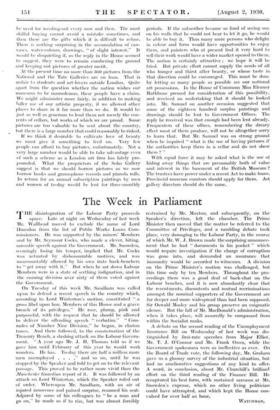Museums or Mausoleums ?
TONE who know our London museums and picture gal- leries and who knew them some quarter of a century ago will deny that their treasures are now more attractively and more intelligently arranged. They used to be behind the rest of Europe ; they are now in the van. Yet there is one respect in which their trustees and directors lag behind. To put the complaint in a sentence, they are not making the best use of the material placed under their care. They appear to think that their duty is to the inhabitants of London and visitors to the capital alone. That duty, we have admitted, is discharged admirably. But their responsibilities should not end there. They have in their cellars large numbers of pictures and objects of interest for which no room can be found in the National and Tate Galleries or in the British Museum. Why should not these be exhibited elsewhere ? There arc plenty of people in other cities, towns and villages who would he grateful for the opportunity to see them. It is a dog-in- the-manger policy to keep them undisplayed, to hoard them up on the off-chance that some day there may be extensions of premises which will enable them to be shown.
In the House of Commons the other day Mr. A. M. Samuel drew out the information that there are 890 pictures stored away in the Tate Gallery (they have been in store for years). The official speaker attempted to justify this by holding out the promise that, when a new wing is built, many of them will be on the walls. In the meantime what excuse can there be for not lending them to galleries which have got room for them and spreading in wider commonalty the joy they are intended to give ? The Parliamentary reply, drawn up of course by the authority in charge of these national possessions, added an unfortunate remark about many of them being " of slight interest." If they are not worth exhibiting, they are not worth the room that they take up. A great merit of our national collections is that they contain less second and third-rate stuff than most institu- tions of the kind in other countries. We ought to guard this reputation jealously. It is inevitable that there should
be need for weeding-out every now and then. The most skilful buying cannot avoid a mistake. sometimes, and then there arc the gifts which it is difficult to refuse. There is nothing surprising in the accumulation of can- vases, water-colours, drawings, " of slight interest." It would be disquieting if, as the reply in the House seemed to suggest, they were to remain cumbering the ground and keeping out pictures of greater merit.
At the present time no more than 360 pictures from the National and the Tate Galleries are on loan. That is unfair to students and art-lovers outside London. Quite apart from the question whether the nation wishes our museums to be mausoleums, these people have a claim. We might administer more fairly, in addition to making fuller use of our artistic property, if we allowed other places to share in it far more than we do. It would be just as well as generous to lend them not merely the con- tents of cellars, but works of which we are proud. Some pictures arc too valuable to be sent about the country, but there is a large number that could reasonably be risked.
If we think it desirable to cultivate love of beauty we must give it something to feed on. Very few people can afford to buy pictures, unfortunately. Not a very large number would be able to take advantage even of such a scheme as a London art firm has lately pro- pounded. What the proprietors of the Soho Gallery suggest is that we should borrow pictures as we now borrow books and gramophone records and pianola rolls. In return for an annual subscription paintings by men and women of to-day would be lent for three-monthly
periods. If the subscriber became so fond of seeing one on his walls that he could not bear to let it go, he would be able to buy it. Thus many more persons who delight in colour and form would have opportunities to enjoy them, and painters who at present find it very hard to sell their work would have a wider market opened to them. The notion is certainly attractive ; we hope it will be tried. But private effort cannot supply the needs of all who hunger and thirst after beauty, or whose taste in that direction could be encouraged. This must be done by letting as many people as possible see our national art possessions. In the House of Commons Miss Eleanor Bathbone pressed for consideration of this possibility, and received an undertaking that it should be looked into. Mr. Samuel on another occasion suggested that some of the eighteen hundred surplus paintings and drawings should be lent to Government Offices. The reply he received was that enough had been lent already. Frequenters of these offices, remembering the dreary effect most of them produce, will not be altogether sorry to learn that. But Mr. Samuel was on strong ground when he inquired " what is the use of having pictures if the authorities keep them in a cellar and do not Show them ? "
With equal force it may be asked what is the use of hiding away things that are presumably both of value and interest in the basement of the British Museuin The trustees have power under a recent Act to make loans. Provincial museum curators should apply for them. Art gallery directors should do the same.

































 Previous page
Previous page